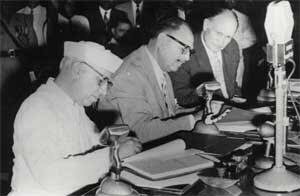Was the Indus Water Treaty a ‘Nehruvian Blunder’?
- In Foreign Policy
- 09:11 PM, Sep 28, 2016
- Sona Roy
In the wake of current developments and all the tension between India and Pakistan, much is being spoken about “The Indus Water Treaty”, remember it’s the Indus that makes Kashmir the jugular vein of Pakistan.
Let’s look into the history of this treaty for a bit-
Indus Water Treaty is an agreement between India and Pakistan over water sharing of Indus River. This treaty was signed in the year 1960 by the then Indian PM Jawaharlal Nehru and Pakistani president Ayub Khan.
Indus also known as Sindhu is one of the longest rivers in Asia, originating in Tibet, running across Ladakh, Gilgit-Baltistan to Khyber Pakhtunkhwa then enters Punjab and eventually meets the Arabian Sea near Karachi. Through its entire course it forms four major tributaries on its left bank- Chenab, Jhelum Ravi, Beas and Satluj. On the right bank it has tributaries- Shyok, Gilgit, Kabul, Gomal and Kurram.
Indus is the major water source for Pakistan and being a country largely dependent on agriculture, it becomes the lifeline for Pakistan economy. When British India was partitioned, and State of Jammu and Kashmir decided to join India, the source of these rivers came under India, the upper riparian and Pakistan the lower though it irrigated 80% of Pakistan. Thus Pakistan’s jugular vein was getting controlled by India.
During 1948 war India had cut off water supplies to the canals crossing into Pakistan and that caused a drought like situation in Pakistan’s Punjab province. Pakistan’s insecurity and sense of vulnerability took birth and with time it dug deep into Pakistani psyche. After a month the canal water was restored and an agreement was signed, recognizing Punjab’s (in India) right to control water supplies to Pakistani Punjab, which was disputed by Pakistan, though India insisted it was just a treaty. Pakistan insisted on taking up the matter with the international court of justice but India refused saying that solution was possible through bilateral resolution.
In 1951, David Lilienthal former chairman of Tennessee Valley Authority, visited India and Pakistan to study the Indus River water sharing. He suggested building of storage facilities and a cooperative management of water resources by both the countries. He sent his proposal to Eugene Black, the president of World Bank for establishing and funding Indus Engineering Corporation comprising representatives from both the countries. Eugene Black wrote to both the country heads offering a solution to the dispute, and in 1952 he in fact visited both the countries with his proposal. But his proposal failed to offer any long term plan, as a result he left it on both the countries to come up with their plans. Year 1953 both countries came up with their plans and again each disputed the other.
In 1954 World Bank came up with its draft which had three core points-
1 Historic withdrawals shall continue
2 Three eastern rivers assigned to India and three western rivers to Pakistan
3 There will be a 5 year transition period for Pakistan to construct its link canals.
The proposal however neither spoke about building storage facilities nor about the integrated development of Indus basin water. This proposal was anyway accepted by India but Pakistan felt deprived as it didn’t speak about dams or storage facilities. After a lot of going back and forth on various issues the fourth and final draft of Indus water treaty was completed by August 1960 and signed in September 1960. The treaty also established the Indus commission and Indus water commissioner in both the countries. As per the treaty India is permitted usage of water of the rivers allocated to Pakistan but flow through India. It is also allowed to build storage of no more than 3.6 million acre feet and can generate hydroelectric power too.
Now let’s see what makes this treaty unfair-
1- The distribution of water as per this treaty was 20% for India and 80% for Pakistan.
2- The treaty talks of water allocation of six tributaries and does not include Kabul River which is the most important tributary, thus permitting Pakistan unbridled use of its water.
3- The division was not done on the basis of quantum of water carried by these rivers. Neither was cultivable land area, dependent population, length of river bed etc. taken into consideration while allocating tributaries.
4- A major bulk of irrigation canals developed by the British went to Pakistan.
5- India was denied the right to generate hydroelectric power without consent of Pakistan.
6- India had to pay 62,000,000 pound sterling to Pakistan for building water infrastructure, and replacement works.
This Indus Water Treaty was one amongst the list of major blunders committed by Jawaharlal Nehru
Last few days there has been a lot of media debate about scrapping this treaty which has been grossly unfair to India and has no clause of exit mentioned. However there are certain points which India can use to its favor to abstain from complying with the treaty and ask for re-negotiations. But we should also remember that stopping Indus water means India needs huge storage facilities, do we have them ready? What India can do are things like release excess water from Salal hydro project or the opposite, but any such step would even make Nepal and Bangladesh feel threatened as both are on the upstream. India is allowed to build storage facilities of 3.6 million acre feet on western rivers which has not been built yet.
Probably starting those projects will be enough to rattle our neighbor. The treaty also permits India to use water from western rivers for 1.32 million acres of agricultural land, while India is using it only for 0.8 million acres. Pulling out more water here will also cause abundant stress to Pakistan. And most importantly J&K is worst hit because of this treaty and India can very well present a case in terms of welfare of J&K. This would also help build some anti Pakistan narrative in the otherwise burning state.
Scrapping or not scrapping the treaty is a long debate and involves lot of international diplomacy as well, but controlling how much water flows down the neighborhood can be a good start.







Comments